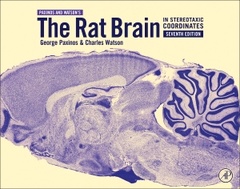Description
The Rat Brain in Stereotaxic Coordinates (7th Ed.)
Hard Cover Edition
Authors: Paxinos George, Watson Charles
Language: English
Subject for The Rat Brain in Stereotaxic Coordinates:
217.38 €
In Print (Delivery period: 14 days).
Add to cart
Publication date: 10-2013
480 p. · 26.4x19.5 cm · Hardback
480 p. · 26.4x19.5 cm · Hardback
Description
/li>Contents
/li>Readership
/li>Biography
/li>Comment
/li>
Since its first edition in 1982, the Paxinos and Watson rat brain atlas has become the most trusted source of accurate coordinates and anatomical information in laboratories throughout the world. It has been cited over 60,000 times, making it the most cited publication in neuroscience. The seventh edition incorporates new findings on developmental gene expression and presents the boundaries of neuromeres in sagittal sections.
Features of the Edition
Introduction
Methods
Stereotaxic reference system
Nomenclature and the construction of abbreviations
The basis of delineation of structures
References
Index of structures
Index of abbreviations
Parts of the rat brain
Figures
Introduction
Methods
Stereotaxic reference system
Nomenclature and the construction of abbreviations
The basis of delineation of structures
References
Index of structures
Index of abbreviations
Parts of the rat brain
Figures
Researchers in neuroanatomy, neurophysiology, and molecular expression/cloning in the rat brain, as well as anyone using the rat as an experimental model.
Professor Paxinos is the author of almost 50 books on the structure of the brain of humans and experimental animals, including The Rat Brain in Stereotaxic Coordinates, now in its 7th Edition, which is ranked by Thomson ISI as one of the 50 most cited items in the Web of Science. Dr. Paxinos paved the way for future neuroscience research by being the first to produce a three-dimensional (stereotaxic) framework for placement of electrodes and injections in the brain of experimental animals, which is now used as an international standard. He was a member of the first International Consortium for Brain Mapping, a UCLA based consortium that received the top ranking and was funded by the NIMH led Human Brain Project. Dr. Paxinos has been honored with more than nine distinguished awards throughout his years of research, including: The Warner Brown Memorial Prize (University of California at Berkeley, 1968), The Walter Burfitt Prize (1992), The Award for Excellence in Publishing in Medical Science (Assoc Amer Publishers, 1999), The Ramaciotti Medal for Excellence in Biomedical Research (2001), The Alexander von Humbolt Foundation Prize (Germany 2004), and more
Charles Watson is a neuroscientist and public health physician. His qualifications included a medical degree (MBBS) and two research doctorates (MD and DSc). He is Professor Emeritus at Curtin University, and holds adjunct professorial research positions at the University of New South Wales, the University of Queensland, and the University of Western Australia.
He has published over 100 refereed journal articles and 40 book chapters, and has co-authored over 25 books on brain and spinal cord anatomy. The Paxinos Watson rat brain atlas has been cited over 80,000 times. His current research is focused on the comparative anatomy of the hippocampus and the claustrum.
He was awarded the degree of Doctor of Science by the University of Sydney in 2012 and received the Distinguished Achievement Award of the Austra
Charles Watson is a neuroscientist and public health physician. His qualifications included a medical degree (MBBS) and two research doctorates (MD and DSc). He is Professor Emeritus at Curtin University, and holds adjunct professorial research positions at the University of New South Wales, the University of Queensland, and the University of Western Australia.
He has published over 100 refereed journal articles and 40 book chapters, and has co-authored over 25 books on brain and spinal cord anatomy. The Paxinos Watson rat brain atlas has been cited over 80,000 times. His current research is focused on the comparative anatomy of the hippocampus and the claustrum.
He was awarded the degree of Doctor of Science by the University of Sydney in 2012 and received the Distinguished Achievement Award of the Austra
- 161 thoroughly revised coronal diagrams and accompanying photographic plates spaced at 120 µm intervals
- 19 thoroughly revised sagittal diagrams and accompanying photographic plates
- 27 thoroughly revised horizontal diagrams and accompanying photographic plates
- Photographic plates printed from high resolution digital images in color
- Diagrams of all spinal cord segments
- The most accurate and virtually universally used stereotaxic coordinate system
- Neuromeric segments delineated in sagittal sections
- A 'mini-atlas' of 14 diagrams to assist beginning students of neuroanatomy
- Over 1000 structures identified
- Electronic diagrams available to purchasers of this book via a companion web site (http://booksite.elsevier.com/9780123919496/)
© 2024 LAVOISIER S.A.S.




